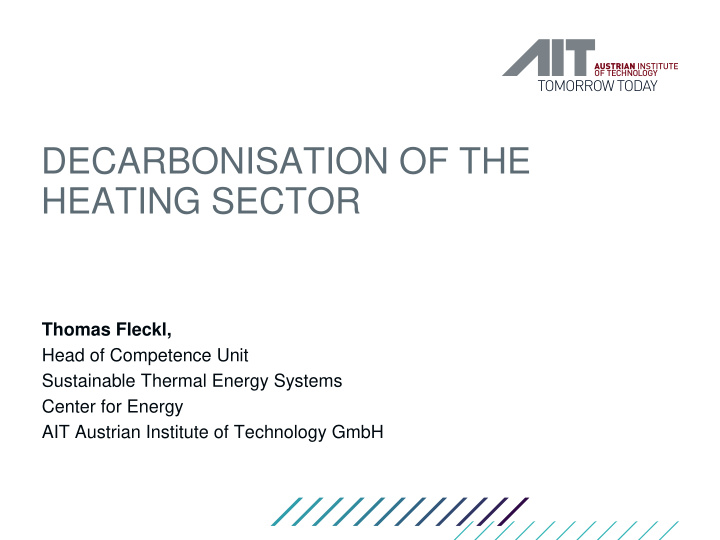



DECARBONISATION OF THE HEATING SECTOR Thomas Fleckl, Head of Competence Unit Sustainable Thermal Energy Systems Center for Energy AIT Austrian Institute of Technology GmbH
DECARBONISATION OF THE ENERGY SYSTEM • Decarbonisation of the energy system • is a challenge due to limited resources. • Reduction of primary energy consumption essential (example Austria: For self-supply approx. 40%, the potential (hydro, biomass, wind, PV) is not big enough) • requires sector coupling • Industry-mobility-heating and cooling in buildings • Different energy carriers (electricity, gas, biomass, ambient/waste heat) • Distribution and storage • needs a deeper insight to Exergy vs. Anergy • Exergy (electricity, high temperature heat, chemically bonded energy) is the backbone of the energy system • Anergy (low temperature heat) has to be used as much as possible, due to conversion efficiencies in power generation (biomass, power to X to power) • Trend goes to electrification of industry and mobility • Cooling/air conditioning as big driver and challenge (see IEA Future of Cooling) 04.10.2018 2
ASPECTS OF TECHNOLOGIES • Building sector: • Increasing comfort requests • Retrofitting as a challenge • Should mainly use Anergy • Single family houses (SFH): PV, thermal (short term and seasonal(?)) and electrical (short term) storages, electro vehicles, heat pumps • Multifamily houses up to districts: the same as SFHs but in addition local thermal grids up to district heating systems (including waste heat, solar thermal heat, seasonal storages) • Industry • Heterogenous processes, therefore different solutions on process level • Increasing on-site efficiency (e.g. high temperature heat pumps) • Distribution of waste heat (Anergy) 04.10.2018 3
STORAGES (INCLUDING CONVERSION TECHNOLOGIES) • Requirements: • MW- scale with capacities up to TWh, space requirements! • Scalable systems for decentralized solutions • Cost competition, “merit order” in between different technologies • Short term storages are the basis for seasonal storages for smoothing of fluctuations of PV and wind-power • Short term storages (days up to weeks) • Hydro, pumped-storage power (large and small scale) • Compressed air • High temperature storages • Batteries • Flywheels • Seasonal storages (>months) • Chemical storages • Biomass • P2X: • C-based, Synthetic fuels (requires seasonal CO2 storages) • N-based (Ammonia) • Thermal storages • High temperature storages • Thermo-chemical storages 04.10.2018 4
CONCLUSIONS • Conclusions from a technology point of view • Within the sector coupling energy storages and distribution are crucial • Most of the technologies available, missing links must be brought on technology readiness in the next 5-10 years • Demonstration and upscaling relevant in the next years 04.10.2018 5
Recommend
More recommend